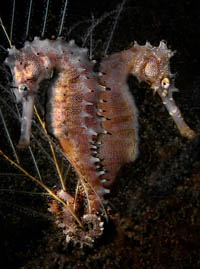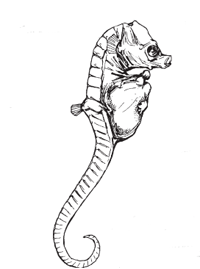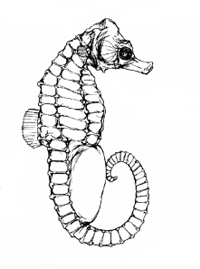Seahorses and seadragons
Hippocampus reidi. Photo by Melissa Rushby/Guylian Seahorses of the World.
Many people are unaware that seahorses and seadragons are in fact fish. They have evolved some interesting adaptations to life in the sea. The combination of a horse-like snout (for sneaking up on small crustaceans), bony plates (to protect them against predators), and in the case of seahorses, a prehensile tail that allows them to cling to seagrasses, corals, and other holdfasts in ocean currents, has enabled these slow-swimming animals to survive for millions of years.
There are 46 recognised species of seahorses. Given their superior camouflage and the subtle differences between some species, taxonomists have long struggled on delineating and identifying them based on appearance alone. The rise of genomics and other molecular techniques will hopefully shed light on this matter and eventually provide a much clearer picture.
The seadragons consist of only three recognized species, the Common seadragon (Phyllopteryx taeniolatus), the Leafy seadragon (Phycodurus eques) and the newly described Ruby seadragon (Phyllopteryx dewysea). They are more mobile than seahorses and tend to orient at a more horizontal angle than their cousins. Learn more about seadragons here.
Check out the profiles of the species we currently recognize below (Lourie et al, 2016).
Seahorses
| Photo | Scientific Name | Common Name | IUCN Red List Status | Profile | Range |
 |
Hippocampus abdominalis
Lesson, 1827 |
Bigbelly seahorse | LC | Australia & New Zealand | |
 |
H. algiricus
Kaup, 1856 |
West African seahorse | VU | W. Africa | |
 |
H. angustus
Günther, 1870 |
Narrow-bellied seahorse | LC | N. Australia | |
 |
H. barbouri
Jordan & Richardson, 1908 |
Barbour's seahorse | VU | Indo-Pacific | |
 |
H. bargibanti
Whitley, 1970 |
Bargibant's pygmy seahorse | LC | Indo-Pacific | |
 |
H. breviceps
Peters, 1869 |
Short-head seahorse | LC | S. Australia | |
 |
H. camelopardalis
Bianconi, 1854 |
Giraffe seahorse | DD | W. Indian Ocean | |
 |
H. capensis
Boulenger, 1900 |
Cape seahorse | EN | S. Africa | |
 |
H. casscsio
Zhang, Qin, Whang & Lin, 2016 |
Beibu Bay seahorse | DD | China | |
 |
H. colemani
Kuiter, 2003 |
Coleman's pygmy seahorse | DD | Indo-Pacific | |
 |
H. comes
Cantor, 1849 |
Tiger-tail seahorse | VU | SE Asia | |
 |
H. coronatus
Temminck & Schlegel, 1850 |
Crowned seahorse | DD | Japan & South Korea | |
 |
H. dahli
Ogilby, 1908 |
Lowcrown seahorse | LC | Northern & Eastern Australia | |
 |
H. debelius
Gomon & Kuiter, 2009 |
Softcoral seahorse | DD | Red Sea | |
 |
H. denise
Lourie & Randall, 2003 |
Denise's pygmy seahorse | LC | Indo-Pacific | |
 |
H. erectus
Perry, 1810 |
Lined seahorse | VU | W. Atlantic | |
 |
H. fisheri
Jordan & Evermann, 1903 |
Fisher's seahorse | LC | Pacific (Hawaii) | |
 |
H. guttulatus
Cuvier, 1829 |
Long-snouted seahorse | DD | Europe & Mediterranean | |
 |
H. haema
Han, Kim, Kai & Senou, 2017 |
Korean seahorse | VU | Korea & Japan | |
 |
H. hippocampus
(Linnaeus, 1758) |
Short-snouted seahorse | DD | Mediterranean, W. Atlantic |
|
 |
H. histrix
Kaup, 1856 |
Thorny seahorse | VU | |
W. Indian Ocean to Central Pacific |
 |
H. ingens
Girard, 1858 |
Pacific seahorse | VU | |
California to Peru |
 |
H. japapigu
Short, Smith, Motomura, Harasti & Hamilton, 2018 |
Japan pig pygmy seahorse | LC | Japan | |
 |
H. jayakari
Boulenger, 1900 |
Jayakar's seahorse | LC | Red Sea to Pakistan | |
 |
H. jugumus
Kuiter, 2001 |
Collar seahorse | DD | Australia | |
 |
H. kelloggi
Jordan & Snyder, 1901 |
Great seahorse | VU | Indo-Pacific to E. Africa to China & Australia | |
 |
H. kuda
Bleeker, 1852 |
Spotted seahorse | VU | Indo-Pacific to E. Africa to China & Australia | |
 |
H. minotaur
Gomon, 1997 |
Bullneck seahorse | DD | S. Australia | |
 |
H. mohnikei
Bleeker, 1853 |
Japanese seahorse | VU | Japan & Korea to Thailand | |
 |
H. nalu
Short, Claassens, Smith, De Brauwer, Hamilton, Stat & Harasti, 2020 |
Sodwana pygmy seahorse | NT | South Africa | |
 |
H. paradoxus
Foster & Gomon, 2010 |
Paradoxical seahorse | DD | SW Australia | |
 |
H. patagonicus
Piacentino & Luzzatto, 2004 |
Patagonian seahorse | VU | Brazil to Argentina | |
 |
H. planifrons
Peters, 1877 |
Flatface seahorse | LC | |
Australia |
 |
H. pontohi
Lourie & Kuiter, 2008 |
Pontoh's pygmy seahorse | LC | |
Indo-Pacific |
 |
H. pusillus
Fricke, 2004 |
Pygmy thorny seahorse | DD | New Caledonia | |
 |
H. reidi
Ginsburg, 1933 |
Slender seahorse | NT | |
North Carolina to Brazil |
 |
H. satomiae
Lourie & Kuiter, 2008 |
Satomi's seahorse | DD | Indo-Pacific | |
 |
H. sindonis
Jordan & Snyder, 1901 |
Sindo's seahorse | LC | |
Japan |
 |
H. spinosissimus
Weber, 1913 |
Hedgehog seahorse | VU | |
Indo-Pacific |
 |
H. subelongatus
Castelnau, 1873 |
West Australian seahorse | DD | |
W. Australia |
 |
H. trimaculatus
Leach, 1814 |
Three-spot seahorse | VU | |
Indo-Pacific |
 |
H. tyro
Randall & Lourie, 2009 |
Tyro seahorse | DD | |
Seychelles |
 |
H. waleananus
Gomon & Kuiter, 2009 |
Walea soft coral pygmy seahorse | CR | Indonesia | |
 |
H. whitei
Bleeker, 1855 |
White's seahorse | EN | |
Solomon Islands, E. Australia |
 |
H. zebra
Whitley, 1964 |
Zebra seahorse | DD | |
Australia |
 |
H. zosterae
Jordan & Gilbert, 1882 |
Dwarf seahorse | LC | |
Gulf of Mexico |
IUCN Red List key
EX = Extinct
EW = Extinct in the Wild
CR = Critically Endangered
EN = Endangered
VU = Vulnerable
NT = Near Threatened
LC = Least Concern
DD = Data Deficient
NE = Not Evaluated
(Click here for a full explanation of IUCN Red List categories.)
A note on ‘Data Deficient’ species: Species that are assessed as ‘Data Deficient’ are deemed to have insufficient information known about them to carry out a proper conservation assessment. Although such species are not assessed as threatened, we may find out that they in fact are, once enough data is obtained.
Banner image of Leafy seadragon (Phycodurus eques) © Gaetano Gargiulo / Guylian Seahorses of the World
[Page updated 11 Aug 2025]




